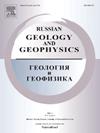Detailed Investigation of Dolomites in the Middle Jurassic Samana Suk Formation, Kahi Section, Nizampur Basin, NW Himalayas, Pakistan
IF 1.2
4区 地球科学
Q3 GEOSCIENCES, MULTIDISCIPLINARY
引用次数: 0
Abstract
—Diagenetically modified carbonate rocks are more common in the rock record. Among these modifications, multiphase dolomitization is the most common process. The Middle Jurassic carbonates of the Samana Suk Formation are extensively altered by the dolomitization process in the Kahi section, Nizampur Basin. The primary objective of this study is to investigate this multiphase dolomitization and to elucidate its possible mechanism. Field investigation shows both host limestone (oolitic, fossiliferous, and massive) and dolomites. Dolomite bodies are of both beddings: parallel to and crosscutting the bedding planes. Different types of dolomites were recognized on the basis of color contrast as dark gray replacive dolomite, light gray dolomite, brownish dolomite, and yellowish dolomite. Along with the replacive phase, void- and fracture-filling cementing saddle dolomite and cementing calcites are recognized in the field. Petrographic studies show the complex diagenetic history of the Samana Suk Formation from near-surface diagenesis, including micritization, neomorphism, and several varieties of dolomites. These varieties are as follows: RD1 is very fine- to fine-grained dolomite; RD2 is medium- to coarse-grained and anhedral to subhedral dolomite; RD3 is coarse- to very coarse-grained and planar euhedral zoned dolomite; and RD4 is coarse-grained euhedral to subhedral ferroan dolomite. In addition, cementing saddle dolomite SD consists of large crystals with curved faces showing sweeping extinction. Cementing calcite phases are as follows: CC1 is granular mosaic; CC2 is twin; CC3 is fracture-filling; and CC4 is ferroan calcite. The stable isotope values of limestone (δ18O is –7.13 to –0.73‰ V-PDB, and δ13C is –0.05 to 1.32‰ V-PDB) show depletion with respect to the Jurassic marine signature. The values of multiphase dolomites RD1–RD4 and SD (δ18O is –8.65 to –3.16‰, and δ13C is –3.56 to 2.09‰) indicate multiphase dolomitization. The CC1–CC3 values (δ18O is –11.07 to –8.97‰, and δ13C is –2.14 to 0.76‰) indicate highly depleted values of δ18O, showing hydrothermal origin. From field, petrography, and geochemistry data, it is deduced that a possible source of Mg for hydrothermal dolomites is activation of faults and fractures during active tectonic regime in the area and might be related to activation and reactivation of the Kahi Thrust system.巴基斯坦西北喜马拉雅山尼赞布尔盆地卡希段中侏罗世萨马纳苏克地层白云岩详查
-在岩石记录中,经过二基因改造的碳酸盐岩更为常见。在这些改造中,多相白云石化是最常见的过程。在尼赞普尔盆地的 Kahi 段,萨马纳苏克地层的中侏罗世碳酸盐岩被白云石化过程广泛改变。本研究的主要目的是调查这种多相白云石化过程,并阐明其可能的机制。实地考察显示,既有寄主石灰岩(鲕状、化石状和块状),也有白云岩。白云岩体有两种层理:与层理平行的和与层理交叉的。根据颜色对比,白云岩可分为深灰色代换白云岩、浅灰色白云岩、褐色白云岩和淡黄色白云岩。除替代相外,现场还发现了空隙和裂缝填充胶结鞍状白云岩和胶结方解石。岩相学研究表明,萨马纳苏克地层近表层成岩历史复杂,包括微晶化、新变质和多种白云岩。这些品种如下:RD1 为极细粒至细粒白云岩;RD2 为中粒至粗粒、正方体至次正方体白云岩;RD3 为粗粒至极粗粒、平面正方体带状白云岩;RD4 为粗粒正方体至次正方体铁质白云岩。此外,胶结鞍状白云石 SD 由大晶体组成,其曲面呈扫掠消光。胶结方解石相如下:CC1 为粒状镶嵌物;CC2 为孪晶;CC3 为裂隙充填物;CC4 为铁方解石。石灰岩的稳定同位素值(δ18O 为 -7.13 至 -0.73‰ V-PDB,δ13C 为 -0.05 至 1.32‰ V-PDB)显示出相对于侏罗纪海相特征的衰竭。多相白云岩 RD1-RD4 和 SD 的值(δ18O 为 -8.65 至 -3.16‰,δ13C 为 -3.56 至 2.09‰)表明多相白云岩化。CC1-CC3值(δ18O为-11.07至-8.97‰,δ13C为-2.14至0.76‰)表明δ18O高度贫化,显示热液成因。根据实地、岩相学和地球化学数据推断,热液白云岩的镁可能来源于该地区活动构造体系期间断层和裂缝的活化,并可能与 Kahi 推力系统的活化和再活化有关。
本文章由计算机程序翻译,如有差异,请以英文原文为准。
求助全文
约1分钟内获得全文
求助全文
来源期刊

Russian Geology and Geophysics
地学-地球科学综合
CiteScore
2.00
自引率
18.20%
发文量
95
审稿时长
4-8 weeks
期刊介绍:
The journal publishes original reports of theoretical and methodological nature in the fields of geology, geophysics, and geochemistry, which contain data on composition and structure of the Earth''s crust and mantle, describes processes of formation and general regularities of commercial mineral occurrences, investigations on development and application of geological-geophysical methods for their revealing. As to works of regional nature, accelerated publication are available for original papers on a variety of problems of comparative geology taking into account specific character of Siberia, adjacent Asian countries and water areas. The journal will also publish reviews, critical articles, chronicle of the most important scientific events, and advertisements.
 求助内容:
求助内容: 应助结果提醒方式:
应助结果提醒方式:


